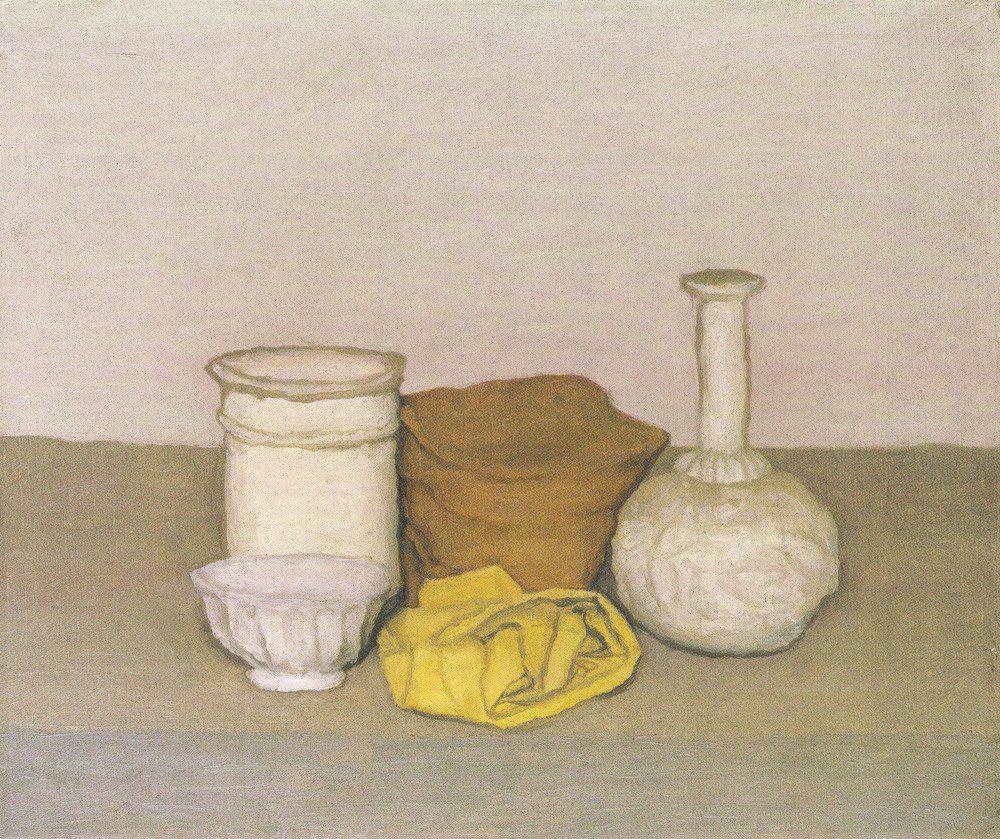Giorgio Morandi (July 20, 1890 – June 18, 1964) was an Italian painter and printmaker who specialized in still life. His paintings are noted for their tonal subtlety in depicting apparently simple subjects, which were limited mainly to vases, bottles, bowls, flowers and landscapes.
 Although he painted generic household objects, critics noted how his representation of these objects conveyed a sense of Morandi’s personality, monastic habits, and Bolognese environment. His tightly unified body of work would be influential for its close study of unremarkable elements of daily life, imbuing them with implications of deeper significance by emphasizing their painterly beauty and simplicity. He represents himself through his paintings and the objects he displayed which links which links to my theme that conventional objects can represent the history of a person.
Although he painted generic household objects, critics noted how his representation of these objects conveyed a sense of Morandi’s personality, monastic habits, and Bolognese environment. His tightly unified body of work would be influential for its close study of unremarkable elements of daily life, imbuing them with implications of deeper significance by emphasizing their painterly beauty and simplicity. He represents himself through his paintings and the objects he displayed which links which links to my theme that conventional objects can represent the history of a person.
With his attention to technique and painstaking precision, Morandi extended the legacy of Italian painting into the 20th century, but gave it new relevance with his minimalist style and non-narrative focus. The sparse palette, clean lines, and careful brushstroke of Morandi’s still lifes are unmistakably modern and his attention to technique and the physicality of the painted surface connected later painters with the grand traditions of the still life and landscape genres.

 The image on the right depicts a display of five domestic objects arranged on a flat table surface: a bottle, a jar and three porcelain bowls of various sizes. The objects are arranged in two horizontal rows, with the three smallest objects situated at the front of the composition and the bottle and a taller bowl at the back. In this work, Morandi uses a muted colour palette that ranges from light and medium grey to cream white, beige, pale yellow and mauve. The ball-shaped container in the front row at the lower left corner of the painting has a top section with yellow grooves and a bottom section with white grooves. The cup in the centre of the composition has a red brim and the bowl on the right side has purple grooves. Still Life is inscribed with the artist’s signature at the bottom right of the canvas.
The image on the right depicts a display of five domestic objects arranged on a flat table surface: a bottle, a jar and three porcelain bowls of various sizes. The objects are arranged in two horizontal rows, with the three smallest objects situated at the front of the composition and the bottle and a taller bowl at the back. In this work, Morandi uses a muted colour palette that ranges from light and medium grey to cream white, beige, pale yellow and mauve. The ball-shaped container in the front row at the lower left corner of the painting has a top section with yellow grooves and a bottom section with white grooves. The cup in the centre of the composition has a red brim and the bowl on the right side has purple grooves. Still Life is inscribed with the artist’s signature at the bottom right of the canvas.
Morandi kept a supply of vases, bottles and jars in his studio, which he used as models for many of his still life paintings in a variety of arrangements. In a letter dated 7 July 1953 the artist wrote that there were ‘several variants of the present work and the same objects also appear in other pictures’



The image above is an oil painting. The canvas is divided into two horizontal segments; the upper half painted pale olive green, the lower, lavender-grey. Three objects – a white vase, a short round container and a conical-topped bottle – rest on the surface. They are arranged close together, one in front of the other, and appear to merge. A sense of spatial depth is introduced through a shadow of the objects, represented by dense strokes of darker paint, that appears on the right-hand side of the composition.
Morandi's studio at Via Fondazza
Morandi painted these familiar objects in his bedroom studio at Via Fondazza in Bologna through almost the whole of his career, only shifting to a rural house, at Grizzana, in 1960. Many of the still lifesof the last four years of his life were made there, alongside paintings of the landscape, and achieve an ethereal quality in which formal similarities are found across the two genres.
The Metaphysical painting(Pittura Metafisica) phase in Morandi’s work lasted from 1918 to 1922.
Metaphysical art: a style of painting developed by the Italian artists Giorgio de Chirico and Carlo Carrà. The movement began in 1911 with de Chirico, whose dreamlike works with sharp contrasts of light and shadow often had a vaguely threatening, mysterious quality
This was to be his last major stylistic shift; thereafter, he focused increasingly on subtle gradations of hue, tone, and objects arranged in a unifying atmospheric haze, establishing the direction his art was to take for the rest of his life.
I decided to chose the artist Giorgio Morandi to take inspiration from when taking still life pictures of objects as his style and arrangements in his paintings are what i want to recreate in my photos with conventional objects. He uses a collection or objects with simple backgrounds and neutral colours to create a simplistic yet detailed paintings.
